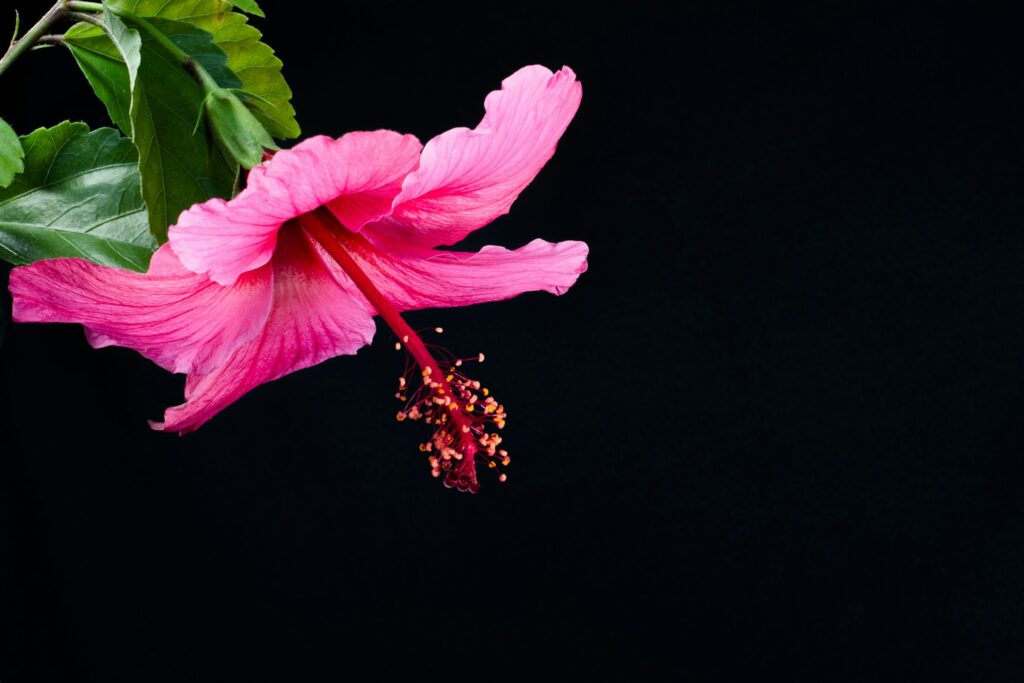
If you wish to provide some striking accent to your living space, the hibiscus flower is a wonderful choice. Popular for its rich, tropical petals and lush foliage, the hibiscus bloom illuminates any house or yard immediately. Apart from adding a flare of color, it creates a pleasant and appealing surrounding fit for leisure or guesting.
Hibiscus flowers are adjustable for a variety of residences since they bloom indoors and outside. Their large, vivid flowers in red, pink, orange, and yellow give homeowners several ways to highlight their design style. Beyond their looks, hibiscus flowers have symbolic value related to enjoyment and beauty, so improving the ambiance of your residence.
How to Care for Your Hibiscus Flower Indoors and Outdoors
Maintaining a hibiscus flower isn’t difficult. Whether your plant lives in the garden or a sunny window, the secret is to satisfy its demands for water, sunlight, and quality of soil.
Hibiscus flowers inside require at least six hours of daily intense, indirect sunshine.
Your plant would be most suited next to a window facing east or west. Warm places where they might spend most of the day soaking in full sun let outdoor hibiscus plants flourish. Make sure the earth is high in organic matter and drains properly to encourage good development and aid in preventing root rot.
Especially in warmer months, regular watering is vital. Still, avoid overwatering; let the top inch of soil dry out between watering intervals. Feeding your hibiscus flower a balanced fertilizer every few weeks during the growing season will help to improve the bloom quality.
Incorporating Hibiscus Flower into Your Home Décor
Highlighting the hibiscus flower in your home décor will turn simple areas into vibrant, reviving havens. Fresh hibiscus blossoms in a vase provide dining tables, coffee tables, or entryways instant elegance and color. Their tropical attitude complements other floral designs like peony quite nicely, thereby enhancing layered, textured home décor.
See our page on peonies in home décor if you want to investigate flower arrangement ideas that go nicely with hibiscus. The soft, full petals of the peony contrast brilliantly with the strong hibiscus to produce a balanced, striking show.
Hibiscus plants would frame your porch or garden elegantly for outdoor living areas. Their vivid blossoms catch people’s attention and make them welcome. To improve your outside look, mix them with imaginative architectural elements, including suggestions for front porch railings. Placing hibiscus pots next to or along your porch railing, for instance, will soften hard lines and add a natural color, complementing metal or wood features.
The Benefits of Hibiscus Flower for a Healthier Home Environment
Apart from their obvious beauty, hibiscus flower can help to improve the surroundings. Growing hibiscus outside attracts helpful pollinators like butterflies and bees, which helps the ecosystems around. Their presence helps your garden to be active, which benefits every one of your plants.
Like many indoor plants, hibiscus flowers inside help clean the air by raising oxygen levels and lowering pollutants. Including a hibiscus flower in your house will help to produce a calmer and invigorating surroundings, thereby enhancing your general state of health.
Many also value flowering plants’ soothing power. Excellent friends in meditation or reading areas, hibiscus blossoms can help one relax and encourage mental clarity.
Creative Ways to Use Hibiscus Flowers in Your Home and Garden
Hibiscus blooms are quite flexible and fit for artistic purposes all around the house. Think beyond just putting hibiscus in pots or garden beds to maximize their impact:
- Hibiscus Flower Arrangements: For seasonal bouquets that accentuate your dining or living room, mix fresh or dried hibiscus flowers with foliage and other blossoms.
- DIY Hibiscus Planters: Create your own Hibiscus Planters to highlight your hibiscus blossom from handcrafted containers or vivid pots. Moss or colorful stones placed around the base improve the look.
- Outdoor Borders and Hedges: Plant hibiscus shrubs for a natural, colorful border that also provides privacy along paths or property margins.
- Complementing Porch and Patio Décor: Hibiscus blossoms accentuate vivid sofas, lanterns, and outdoor rugs to create a tropical haven in your garden.
For those looking to improve their porch décor, these front porch railing ideas provide creative solutions to mix architectural details with rich flora like hibiscus.
Troubleshooting Common Hibiscus Flower Care Issues
Although hibiscus blossoms are rather robust, improper care can cause problems. Common problems consist in:
- Yellowing leaves: Often indicating overwatering or inadequate drainage, yellowing leaves Check soil moisture and modify water flow.
- Lack of blooms: Lack of blooms could be caused by either a nutritional shortfall or inadequate sunshine. Move the plant into a sunnier location and apply a fertilizer meant to increase blooms.
- Pests: Aphids, spider mites, and whiteflies can periodically affect hibiscus plants. Check your plant often, and if necessary, utilize natural pest control methods, including neem oil.
Early resolution of these issues guarantees the health, vividness, and ongoing delight your hibiscus flower brings to your house.
Final Thoughts
Including the hibiscus flower in your house and yard provides more than simply a cosmetic improvement; it’s a means of livening your living space with color, happiness, and a little magic from nature. Whether you are a novice trying to liven your area or a seasoned gardener, hibiscus flowers offer a satisfying and somewhat simple-care experience.
To create amazing home décor, pair your hibiscus with other lovely blossoms like peonies; also, keep in mind porch additions that highlight your plants most. The hibiscus bloom can become a cherished feature of the character of your house with just care and affection.
Bring this tropical appeal into your house right now to enjoy the delight alone the vivid hibiscus flower can provide.




